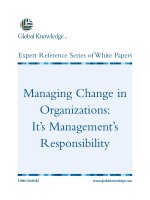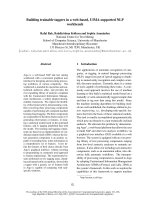building innovation capability in organizations
Bạn đang xem bản rút gọn của tài liệu. Xem và tải ngay bản đầy đủ của tài liệu tại đây (1.1 MB, 275 trang )
BUILDING INNOVATION
CAPABILITY IN ORGANIZATIONS
An International Cross-Case Perspective
Series on Technology Management*
Series Editor: J. Tidd (Univ. of Sussex, UK)
ISSN 0219-9823
Published
Vol. 3
From Knowledge Management to Strategic Competence
Measuring Technological, Market and Organisational Innovation (2nd Edition)
edited by J. Tidd (Univ. of Sussex, UK)
Vol. 4
Japanese Cost Management
edited by Y. Monden (Univ. of Tsukuba, Japan)
Vol. 5
R&D Strategy on Organisation
Managing Technical Change in Dynamic Contexts
by V. Chiesa (Univ. degli Studi di Milano, Italy)
Vol. 6
Social Interaction and Organisational Change
Aston Perspectives on Innovation Networks
edited by O. Jones (Aston Univ., UK), S. Conway (Aston Univ., UK)
& F. Steward (Aston Univ., UK)
Vol. 7
Innovation Management in the Knowledge Economy
edited by B. Dankbaar (Univ. of Nijmegen, The Netherlands)
Vol. 8
Digital Innovation
Innovation Processes in Virtual Clusters and Digital Regions
edited by G. Passiante (Univ. of Lecce, Italy), V. Elia (Univ. of Lecce,
Italy) & T. Massari (Univ. of Lecce, Italy)
Vol. 9
Service Innovation
Organisational Responses to Technological Opportunities and
Market Imperatives
edited by J. Tidd (Univ. of Sussex, UK) & F. M. Hull (Fordham Univ., USA)
Vol. 10 Open Source
A Multidisciplinary Approach
by M. Muffatto (University of Padua, Italy)
Vol. 11 Involving Customers in New Service Development
edited by B. Edvardsson, A. Gustafsson, P. Kristensson,
P. Magnusson & J. Matthing (Karlstad University, Sweden)
Vol. 12 Project-Based Organization in the Knowledge-Based Society
by M. Kodama (Nihon University, Japan)
Vol. 13 Building Innovation Capability in Organizations
An International Cross-Case Perspective
by M. Terziovski (University of Melbourne, Australia)
*For the complete list of titles in this series, please write to the Publisher.
Yvonne - BuildingInnovation.pmd
2
11/22/2007, 6:30 PM
SERIES ON TECHNOLOGY MANAGEMENT - VOL. 13
BUILDING INNOVATION
CAPABILITY IN ORGANIZATIONS
An International Cross-Case Perspective
Mile Terziovski
University of Melbourne, Australia
Imperial College Press
Published by
Imperial College Press
57 Shelton Street
Covent Garden
London WC2H 9HE
Distributed by
World Scientific Publishing Co. Pte. Ltd.
5 Toh Tuck Link, Singapore 596224
USA office: 27 Warren Street, Suite 401-402, Hackensack, NJ 07601
UK office: 57 Shelton Street, Covent Garden, London WC2H 9HE
Library of Congress Cataloging-in-Publication Data
Terziovski, Milé.
Building innovation capability in organizations : an international cross-case
perspective / by Milé Terziovski.
p. cm. -- (Series on technology management ; vol. 13)
Includes bibliographical references and index.
ISBN-13: 978-1-86094-765-0
ISBN-10: 1-86094-765-4
1. Technological innovations--Case studies. 2. International business
enterprises--Case studies. 3. New products--Case studies. 4. Electronic
commerce--Case studies. 5. Sustainable development--Case studies. I. Title.
HD45.T3985 2007
658.4'063--dc22
2007029986
British Library Cataloguing-in-Publication Data
A catalogue record for this book is available from the British Library.
Copyright © 2007 by Imperial College Press
All rights reserved. This book, or parts thereof, may not be reproduced in any form or by any means,
electronic or mechanical, including photocopying, recording or any information storage and retrieval
system now known or to be invented, without written permission from the Publisher.
For photocopying of material in this volume, please pay a copying fee through the Copyright
Clearance Center, Inc., 222 Rosewood Drive, Danvers, MA 01923, USA. In this case permission to
photocopy is not required from the publisher.
Typeset by Stallion Press
Email:
Printed in Singapore.
Yvonne - BuildingInnovation.pmd
1
11/22/2007, 6:30 PM
B516_FM.qxd
8/29/2007
2:00 PM
Page v
FA
To my family whose unconditional love and faith
has been a source of inspiration
B516_FM.qxd
8/29/2007
2:00 PM
Page vi
FA
This page intentionally left blank
B516_FM.qxd
8/29/2007
2:00 PM
Page vii
FA
Preface
As organizations integrate further into the global economy, managers
need to predict their competitive outlook and rapidly adapt their
innovation strategies to meet their competitors head on. Many studies have been published and indeed special issues of top flight management journals have been devoted to innovation, yet the drivers of
success in systematic innovation are not well understood from a theoretical level, hence existing practical insights are not well-founded.
The book takes an international cross-case perspective to explore
how organizations build innovation capability. Eight case studies were
developed in France, Germany, Australia and Thailand, in various
industry sectors, ranging from manufacturing, mining, biotechnology
and computers. Each case study explores the role of the central constructs of e-Commerce, sustainable development orientation (SDO)
and New Product Development (NPD) in developing innovation
capability for the respective organization.
The book justifies the efficacy of building innovation capability so
that the present manager’s perception of innovation as a technicallydriven strategy is expanded to include innovation as a competitive
business strategy. The book primarily informs managers and management researchers in terms of “what works, why and how it works” in
building innovation-driven organizations. Based on qualitative multiple cross-case analysis, the book articulates the dimensions of innovation capability in organizations, and how innovation capability is
developed and exploited. The key drivers of innovative organizations
are also identified.
The “breakthrough” contribution of this book is to identify and
crisply articulate innovation capability in a comprehensive manner,
and as an integrative construct. Most previous books have focused on
only one aspect of innovation capability, perhaps reflecting the specialized nature of these past researchers. This book takes an integrative multi-case study perspective.
vii
B516_FM.qxd
8/29/2007
2:00 PM
Page viii
FA
viii
Preface
The book develops new theory in the field of innovation management that leads to new conclusions of general value and practical
insights for executives wishing to improve the innovation outcomes of
their firms. Conversely, we identify which practices create the greatest
barriers to innovation, and hence should be addressed in more detail
during the commercialization process. This will prevent the waste of
scarce organizational resources. Identifying time delays between the
introduction of an innovative idea and improvement in the company’s
corporate performance is valuable because it will help reassure managers
that innovation is a worthwhile investment, even if it does take time.
Milé Terziovski
Melbourne, Australia
February 2007
B516_FM.qxd
8/29/2007
2:00 PM
Page ix
FA
Acknowledgments
I wish to acknowledge the Australian Research Council (ARC) for
providing funds for the development of the case studies and my
co-grantee, Professor Danny Samson, who has had a significant impact
on my academic career.
I would also like to acknowledge the research team: Dr Isabel
Metz, Ms Elizabeth Najdovski, Dr Susu Nousala and Mr Ordan
Andreevski for their significant contributions.
A special acknowledgment to the case study co-authors: Isabel
Metz, Danny Samson, B. Sebastian Reiche, Ordan Andreevski,
Christopher Barnes, Susu Nousala, Suthida Jamsai, and Amy Lai.
Furthermore, I acknowledge the in-kind contribution provided
by the respondents from each of the case study companies. Without
their contribution, this book would not have been possible.
Finally, a special acknowledgment to Ms Yvonne Tan from World
Scientific Publishing/Imperial College Press, whose advice and support
made this book possible.
ix
B516_FM.qxd
8/29/2007
2:00 PM
Page x
FA
This page intentionally left blank
B516_FM.qxd
8/29/2007
2:00 PM
Page xi
FA
About the Author
Milé Terziovski is an Associate Professor of Innovation and
Entrepreneurship in the Department of Management and Marketing
at The University of Melbourne, where he teaches at undergraduate,
postgraduate and executive levels. He has won the Dean’s Award of
Teaching Excellence for three consecutive years. He is also the
Executive Director of the Centre for Global Innovation and
Entrepreneurship at The University of Melbourne, where he has won
three research grants from the Australian Research Council and two
grants from the Department of Education Science and Training under
the International Science Linkages Program to collaborate with
European partners funded under the 5th and 6th EU Framework
Programs.
After completing his PhD at The Melbourne Business School in
1996, he worked as a tenured Senior Lecturer in the Department of
Management at Monash University. Prior to his academic career,
Professor Terziovski worked for Rio Tinto for 16 years as an engineer
in maintenance, production and project management. He has published more than 40 journal articles, 2 books and 2 in-press, 15 book
chapters and more than 50 conference papers. He has published 3
articles in the prestigious Journal of Operations Management, winning
the Best Paper award in 1999. His paper, based on his PhD thesis, has
been in the top 10 most requested papers for the past five years. He
has also been Guest Editor of the International Journal of Manufacturing Technology Management and has presented at the Academy of
Management on several occasions, receiving a nomination for Best
International Paper in 2000.
Professor Terziovski recently chaired the Innovation and
Entrepreneurship Track at the European Academy of Management
Conference (EURAM 2006) in Norway. He serves on two journal
xi
B516_FM.qxd
8/29/2007
2:00 PM
Page xii
FA
xii
About the Author
Editorial Review Boards in the USA and two in the UK. He also
served as an Advisor to the late President of the Republic of
Macedonia, Mr Boris Trajkovski, on Innovation and Entrepreneurship,
and is currently the Project Leader for the Global Manufacturing
Research Group (GMRG) Project in Macedonia.
B516_FM.qxd
8/29/2007
2:00 PM
Page xiii
FA
Contents
Preface.....................................................................................
Acknowledgments...................................................................
About the Author...................................................................
vii
ix
xi
Chapter 1 Introduction.........................................................
1
Milé Terziovski
1.1
1.2
1.3
1.4
1.5
1.6
1.7
Definitions of Innovation ..............................................
Evolution of Innovation................................................
Innovation Capability....................................................
Enablers of Innovation Capability .................................
Collaboration and Knowledge Transfer .........................
Development of the Case Studies ..................................
Overview of Book Chapters ..........................................
1
3
4
6
10
12
14
Chapter 2 Development of an Integrated Innovation
Capability Model..................................................
19
Isabel Metz, Milé Terziovski and Danny Samson
2.1
2.2
2.3
2.4
2.5
2.6
2.7
2.8
2.9
2.10
Introduction .................................................................
Objectives ....................................................................
Literature Review..........................................................
External Factors That Influence Innovation ..................
Internal Factors That Influence Innovation ...................
Integrating e-Commerce, Sustainable
Development, NPD and Innovation Capability .............
Sustainable Development (SD)......................................
Future Research Agenda ..............................................
Synthesis of the Discussion............................................
Conclusion ...................................................................
xiii
19
20
21
22
25
37
40
43
46
48
B516_FM.qxd
8/29/2007
2:00 PM
Page xiv
FA
xiv
Contents
Chapter 3 Strategic Shift from Product Orientation
to Innovative Solutions Capability in
the German Biotechnology Industry:
Sartorius AG ........................................................
51
Milé Terziovski and B. Sebastian Reiche
3.1
3.2
3.3
3.4
3.5
3.6
3.7
3.8
Introduction .................................................................
Company Background ..................................................
Business Strategy...........................................................
Mission Statement.........................................................
Core Competencies.......................................................
Innovation Strategy.......................................................
Resource Availability .....................................................
Collaboration with External Partners and
Absorptive Capacity ......................................................
Complementary Assets ..................................................
Innovation Capability....................................................
Knowledge Management...............................................
Sustainable Development ..............................................
e-Commerce .................................................................
New Product Development...........................................
Organizational Performance..........................................
Human Resource Management .....................................
Customer Orientation ...................................................
Stakeholder Management..............................................
Conclusion ..................................................................
58
59
60
61
62
64
65
66
68
69
69
70
Chapter 4 Managing Strategic Change Through
Mainstream and Newstream Innovation
at Eurocopter, France ..........................................
73
3.9
3.10
3.11
3.12
3.13
3.14
3.15
3.16
3.17
3.18
3.19
51
52
54
54
55
56
57
Milé Terziovski and B. Sebastian Reiche
4.1
4.2
4.3
Introduction .................................................................
Case Study Interview ....................................................
Company Background ..................................................
73
74
75
B516_FM.qxd
8/29/2007
2:00 PM
Page xv
FA
Contents
4.4
4.5
4.6
4.7
4.8
xv
Core Competencies.......................................................
Innovation Approach ....................................................
Resource Availability .....................................................
Mainstream and Newstream Capabilities .......................
Stage 1: Innovation of the Blade Repair
Process..........................................................................
The Role of Strategic Alliances......................................
Interaction of Mainstream and Newstream....................
Human Resource Management .....................................
Conclusion ...................................................................
Implications for Managers.............................................
79
81
82
83
84
85
Chapter 5 Leveraging Innovation Capabilities
at Caterpillar Underground
Mining (UGM) Pty Ltd ......................................
87
4.9
4.10
4.11
4.12
4.13
75
76
77
77
Milé Terziovski and Ordan Andreevski
5.1
5.2
5.3
5.4
5.5
5.6
5.7
5.8
5.9
5.10
5.11
5.12
5.13
Introduction .................................................................
Company Background .................................................
Perception and Definition of Innovation .......................
Innovation Strategy ......................................................
Core Competencies/Innovation Capability
Development at UGM ..................................................
Resource Availability .....................................................
The Role of Sustainable Development in Building
Innovation Capability....................................................
The Role of e-Commerce in Building Innovation
Capability .....................................................................
The Role of New Product Development (NPD)
in Building Innovation Capability .................................
Organizational Performance..........................................
Leadership and Culture.................................................
Lessons Learned and Opportunities for
Improvement ................................................................
Conclusion ..................................................................
87
88
90
90
91
94
95
97
99
100
101
103
103
B516_FM.qxd
8/29/2007
2:00 PM
Page xvi
FA
xvi
Contents
Chapter 6 Drivers of Innovation Capability at
Sun Microsystems (SMS)..................................... 105
Milé Terziovski and Christopher Barnes
6.1
6.2
6.3
6.4
6.5
6.6
6.7
6.8
6.9
6.10
6.11
6.12
6.13
Introduction .................................................................
Company Background ..................................................
Corporate Strategy........................................................
Mission Statement.........................................................
Core Competencies.......................................................
Innovation Strategy.......................................................
Resource Availability and Absorptive Capacity...............
Innovation Capability....................................................
The Role of e-Commerce in Building Innovation
Capability .....................................................................
The Role of New Product Development (NPD)
in Building Innovation Capability .................................
Organizational Performance .........................................
Opportunities for Improvement ....................................
Conclusion ..................................................................
105
106
107
108
109
109
111
112
114
115
117
117
118
Chapter 7 Development and Exploitation of
Innovation Capability at a Defence
Project Engineering Company (DPEC) .............. 121
Susu Nousala and Milé Terziovski
7.1
7.2
7.3
7.4
7.5
7.6
7.7
7.8
7.9
7.10
Introduction .................................................................
Company and Industry Background..............................
Company Characteristics ...............................................
Perception and Definition of Innovation .......................
R&D Department.........................................................
Corporate Strategy........................................................
Organizational Innovation Capability ............................
Manufacturing and Services ..........................................
Sustainable Development (SD)......................................
e-Commerce (e-Communication) .................................
121
121
122
123
123
124
124
128
129
130
B516_FM.qxd
8/29/2007
2:00 PM
Page xvii
FA
7.11
7.12
7.13
7.14
7.15
7.16
Contents
xvii
New Product Development (Through Project
Management) ...............................................................
Self-Assessment and Continuous Improvement .............
Key Lessons Learnt .......................................................
Organizational Performance..........................................
Opportunities for Improvement ....................................
Conclusion ...................................................................
131
132
133
135
136
138
Chapter 8 Drivers of Innovation Capability for
Effective Sustainable Development:
Best Practice at Vaisala ....................................... 141
Milé Terziovski and B. Sebastian Reiche
8.1
8.2
8.3
8.4
8.5
8.6
8.7
8.8
8.9
8.10
8.11
Introduction .................................................................
Company Background ..................................................
Core Competencies.......................................................
Mission Statement.........................................................
Resource Availability .....................................................
Innovation Strategy.......................................................
Innovation Capability Model.........................................
Drivers of Innovation Capabilities at Vaisala ..................
Integration of Innovation Capabilities ...........................
Supporting Capabilities .................................................
Conclusion ...................................................................
141
142
144
145
145
145
147
147
152
153
154
Chapter 9 Developing Innovation Capability Through
Intellectual Property Strategy in the
Australian Biotechnology Industry:
Starpharma ........................................................... 157
Milé Terziovski and Amy Lai
9.1
9.2
9.3
Introduction ................................................................ 157
Innovation Capability and Commercialization
Success.......................................................................... 158
Biotechnology in Australia ............................................ 158
B516_FM.qxd
8/29/2007
2:00 PM
Page xviii
FA
xviii
9.4
9.5
9.6
9.7
9.8
9.9
9.10
9.11
9.12
9.13
9.14
9.15
9.16
9.17
Contents
Background to Starpharma............................................
Corporate Structure and Business Strategy ....................
Workforce and Culture..................................................
Core Activities, Products and Services ...........................
Intellectual Property Strategy ........................................
Alignment with Business Strategy..................................
Protection and Management .........................................
Networks and Collaborations ........................................
Resource Allocation ......................................................
Innovation Capability....................................................
Implementation of Protection and Management ...........
Systems and Information Technology............................
Conclusion ..................................................................
Implications for Managers.............................................
160
160
162
163
164
164
165
167
168
169
170
172
173
174
Chapter 10 Development of Innovation Capability
at Invincible Company in Thailand .................. 177
Suthida Jamsai, Susu Nousala and Milé Terziovski
10.1
10.2
10.3
10.4
10.5
10.6
10.7
10.8
Introduction .................................................................
Company Background ..................................................
Company Strategy ........................................................
Current Level of Performance.......................................
Invincible Customers ....................................................
Product Innovation.......................................................
Product Innovation Process ..........................................
Conclusion ...................................................................
177
179
180
181
181
182
185
188
Chapter 11 Multiple Cross-Case Analysis:
Conclusions and Implications ........................... 191
Milé Terziovski
11.1
11.2
11.3
Introduction ................................................................. 191
Vision and Strategy ....................................................... 192
Harnessing the Competence Base ................................. 195
B516_FM.qxd
8/29/2007
2:00 PM
Page xix
FA
Contents
11.4
11.5
11.6
11.7
11.8
11.9
11.10
11.11
11.12
11.13
11.14
11.15
11.16
Leveraging Information and Organizational
Intelligence — Absorptive Capacity...............................
Possessing a Market and Customer Orientation.............
Creativity and Idea and Knowledge Management..........
Organizational Structures and Systems ..........................
Culture and Climate .....................................................
Management of Technology and Its Use .......................
New Product Development (NPD) ...............................
Sustainability.................................................................
e-Commerce ................................................................
Characteristics of an Innovative Organization................
Innovation-Driven Organizations: The Role of
NPD, SDO and e-Commerce .......................................
Conclusion ...................................................................
Implications for Managers.............................................
xix
200
204
207
210
213
216
219
222
225
227
232
233
234
References ............................................................................... 237
Index ..................................................................................... 249
B516_FM.qxd
8/29/2007
2:00 PM
Page xx
FA
This page intentionally left blank
B516_Ch-01.qxd
8/29/2007
1:57 PM
Page 1
FA
Chapter 1
Introduction
Milé Terziovski
1.1 Definitions of Innovation
The study of innovation appears in different literatures such as sociology, education, management, etc. In the management literature, two
schools of innovation research have been identified by Subramanian and
Nilakanta (1996). The first domain is that developed by marketing
researchers who are interested in understanding the causes of innovative behavior of consumers, where the consumer is used as the unit of
analysis. The second domain of innovation management research is that
developed by researchers in areas of organizational theory and strategic
management, where the organization is used as a unit of analysis. We
have chosen the second domain for the purpose of this study. There are
many definitions of innovation in the literature. Damanpour (1991)
defines innovation from an organizational perspective:
the adoption of an idea or behavior, whether a system, policy, program, device, process, product or service, that is new to the adopting organization.
Porter and Stern (1999, p. 12) define innovation from a customer
perspective as
… the transformation of knowledge into new products, processes,
and services — involves more than just science and technology. It
involves discerning and meeting the needs of the customers.
Others view innovation as an enabling device for producing new
products and processes on a continuous basis (Dougherty & Hardy,
1
B516_Ch-01.qxd
8/29/2007
1:57 PM
Page 2
FA
2
M. Terziovski
1996). Innovation is about using knowledge to offer a new product
or service to customers via lower costs or improved attributes (Afuah,
1998). Such improvements can emerge from innovations that are
either of a product or process nature. Adding to the dilemma of defining innovation, there are also questions of whether an innovation is of
a radical or incremental nature.
Incremental innovations occur continuously in the organization
and lead to minor improvements in products or processes. Jha et al.
(1996) define continuous improvement (CI) as a collection of activities that constitute a process intended to achieve performance
improvement.
In manufacturing, these activities primarily involve simplification
of production processes, chiefly through the elimination of waste. In
service industries and the public sector, the focus is on simplification
and improved customer service through greater empowerment of
individual employees and correspondingly less bureaucracy (Samson
& Terziovski, 1999; Schroeder et al., 2002). On the other hand, radical innovations are more long-term and strategic in focus, and aim to
change key capabilities of the firm, thus creating a new operating
paradigm. According to Harrington (1995), “all organizations need
both continuous and breakthrough improvement.”
However, according to Harrington, continuous improvement is the
major driving force behind any improvement effort. Breakthrough
improvement serves to “jump-start” a few of the critical processes.
Several researchers are concerned that past research has focused on technological and technical product innovation to the neglect of process
and organizational innovation. For example, Harvard Business School
researchers Kim and Mauborgne (1999) integrate customer value with
technology innovation under the term “value innovation.” Innovation
often is least effective when there is application without considering
who will value the development, either as internal or external customers.
Technology innovation on its own does not address buyer value, thus a
new technology might not be accepted in the market as having value
for the customer. Technology innovation tends to focus on specific
solutions, whereas value innovation focuses on redefining and solving
the problem which leads to a customized solution.
B516_Ch-01.qxd
8/29/2007
1:57 PM
Page 3
FA
Introduction
3
Many of the definitions of innovation discussed above are quite
broad. A global definition of innovation does not exist; rather, different definitions of innovation are appropriate under different circumstances. A narrow definition of innovation may be a useful tool in
researching the activities that lead to greater organizational performance. The following definition of innovation has been articulated by
the Author:
Innovation is the application of resources to create value for the customer and the enterprise by developing, improving and commercializing new and existing products, processes and services.
1.2 Evolution of Innovation
Since the 1930s, our view of what constitutes “innovation” has
changed. Rothwell (1994) explains the evolution of innovation along
five generations of behavior:
First generation innovation (1G) — technology push. This era of
innovation was the foundation for the Industrial Revolution.
Innovation came with new, technologically advanced products and
means of production. Such products were pushed onto the market.
Second generation innovation (2G) — need pull. Innovation during
this era shifted to a market/customer focus, a focus where the customer determined needs and production technology responded.
Marketing took a pivotal role in generating new ideas.
Third generation innovation (3G) — coupling model. This era of
innovation involved a coupling of the push and pull models. The market might need new ideas, but production technology refined them.
Alternatively, R&D developed new ideas that marketing refined with
market feedback. R&D and marketing were linked.
Fourth generation innovation (4G) — integrated model. An integrated model of innovation saw a tight coupling of marketing and
R&D activity, together with strong supplier linkages and close coupling with leading customers.
B516_Ch-01.qxd
8/29/2007
1:57 PM
Page 4
FA
4
M. Terziovski
Fifth generation innovation (5G) — systems integration and networking model (SIN). This model of innovation builds on the integrated model by including strategic partnerships with suppliers and
customers, using expert systems, and having collaborative marketing
and research arrangements. There is an emphasis on flexibility and
speed of development with a focus on quality and other non-price
factors.
According to Rothwell (1994, p. 22), fifth generation (5G)
innovation has both strategic and enabling characteristics. Strategic
elements include time-based strategies (faster, more efficient product
development); a development focus on quality and other non-price
factors; an emphasis on corporate flexibility and responsiveness; a
customer focus at the forefront of any strategy; a strategic integration
with primary suppliers; electronic data processing strategies; and a
policy of quality control. Enabling factors include a greater level of
overall organization and systems integration; a flatter, more flexible
organizational structure for rapid and effective decision-making;
fully developed internal databases; and an effective external data link.
Rothwell (1994) claims that there are examples of Japanese firms
operating on fourth generation innovation, and U.S. firms operating
on third generation innovation, but the presence of fifth generation
innovation is still emerging. The eight case studies discussed in this
book fall between third and fourth generation innovation companies.
1.3 Innovation Capability
As innovation evolved from 1G to 5G, new enabling factors and
drivers of innovation have also evolved: e-Commerce, sustainable
development and a focus on accelerating new product development.
These are taking leading roles in helping to transform knowledge
into new products, processes and services. As organizations have downsized and worked on cost reduction for many decades now, and similarly improved their quality and service, they have generally achieved
efficiency and process stability outcomes. The next battlefield that
will drive international competitiveness and business outcomes of









